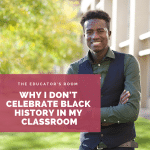As February comes to a close, another Black History Month ends. No doubt, educators around North America and the world hopefully spent this month intentionally highlighting Black people and their achievements, and their contributions to our societies. Growing up in Jamaica, I hadn’t really had much experience with Black History Month (apart from seeing the segments on the Disney channel where they share information about ‘important’ Black Americans), because a lot of Jamaican history is shaped by Black history. The intentional acknowledgment of Black history in February is important but it should not be the only time that it is integrated into the classroom.
As educators, we should always be integrating Black history in our curriculum, despite the subject we teach, throughout the entire school year. Furthermore, non-Black teachers should consciously be educating themselves about how to support the Black community, and be allies to the issues that face our community.
As educators, here are some ways in which you can celebrate Black history all year round:
- Support Black-owned bookstores: As educators, and members of a school district, we will inevitably be purchasing books for our classrooms-whether it is novels, textbooks, etc. As such, it is important that we support spaces that are run and owned by Black entrepreneurs. This puts coins into the hands of Black communities, strengthens the overall economy, and promotes Black culture. If you’re a teacher and buying books for your classroom, consider buying from Black bookstores. Check out some Black-owned bookstores: here (United States) and here (Canada).
- Amplify Black voices in the classroom – This goes without saying but if you’re teaching English, History, Social Studies or another subject within the humanities, you must include novels by and about Black characters, you must not whitewash historical events, and you should discuss how social theories are related to Black communities. Again, these materials should not only be focused on Black trauma or pain. These can be triggering and reinforce a negative idea of Black persons that they are only defined by suffering. You need to include stories and moments from history about Black communities that functioned on their own, fictional Black characters who are protagonists and whose storylines are more than just brutality.
- Fight for anti-racism in your school – It’s important that we are not just learning, and teaching about Black history, but we must also fight to protect our Black students and faculty through the creation and enforcement of anti-racist schools. Too often, schools unfairly punish Black students, fail to learn about the cultures of their Black students, allow for racist comments to be said to Black students and other discriminatory acts to be meted out to their Black students, which in turn leads our Black students to feel alone, unsafe and threatened. All teachers and faculty should be working to ensure that their schools and district are anti-racist. It’s not nearly enough to talk the talk, but we must also walk the walk.
- Allyship – Non-Black educators in particular need to be allies to their Black counterparts in the fight against racial injustice. A lot of non-Black folks will claim to be an ally but then when they are faced with a situation when they need to be at the side of a Black colleague, friend, student, community member, or even a stranger, they run away. If you’d like specific ways in which a white person, read the following article. In particular, look at #6 and examine how you can actively work to dismantle systems of oppression, starting with the school system.
This is a topic that I feel particularly passionate about and I’ve written two articles, which challenge us to think about how we, as educators, can protect our students of colour and ensure that we are actively working to tear down oppressive structures. This article asks you to think about whether your school is actually taking a stand against racial injustice. This article speaks to the importance of checking in with your Black co-workers and black staff, while also pushing non-Black staff and administrators to make actual change in regards to racial equity and justice within their school and district.
Remember, Black History is History and you must be organically integrating it within your teaching, throughout the year.






